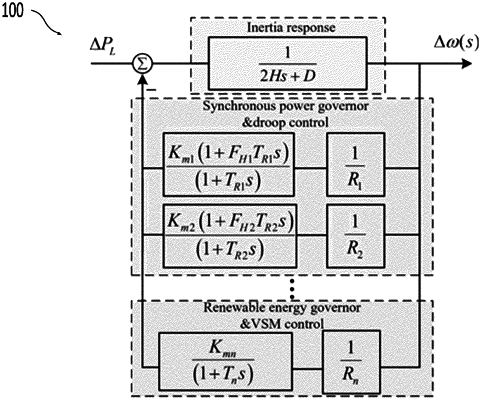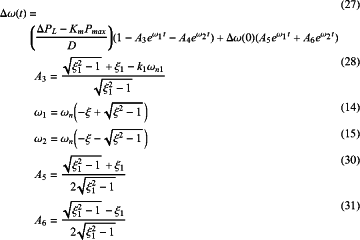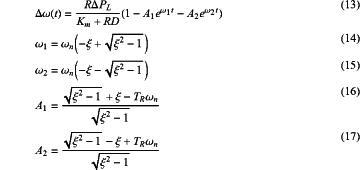| CPC H02J 3/381 (2013.01) [G05B 17/02 (2013.01); H02J 3/0012 (2020.01)] | 1 Claim |

|
1. A method for primary frequency regulation (PFR) reserve procurement of a renewable energy power system, wherein the renewable energy power system includes synchronous power sources and renewable energy sources, and the renewable energy sources participate in frequency regulation using virtual synchronous machine (VSM) control, the method comprising:
aggregating generators in the synchronous power sources and the renewable energy sources into an equivalent unit having an equivalent governor, wherein a governor limiter ΔPmax and a primary frequency modulation gain 1/R of the equivalent governor are determined as
 wherein:
g represents an index of generator in the renewable energy power system, Kmg=Sg/Ssys, Kmg is a standardized parameter of a unit normalized to a system capacity, S g is a capacity of the generator in the renewable energy power system;
based on the equivalent unit, determining system frequency dynamics of the renewable energy power system in s-domain (Δω(s)), as
where
 where:
Δω(s) is a system frequency deviation in Laplace-domain, ΔPL is an active power disturbance, Km is an equivalent Kmg of an equivalent unit aggregated generators in synchronous power sources and renewable energy sources, Pmax is a power limitation of an equivalent governor, D is electrical load demands of the equivalent governor, s is an operator in Laplace-domain, ξ1 is a damping ratio, ωn1 is a natural frequency, Δω0 is frequency deviation values for non-zero initial states in Laplace-domain;
transforming the equation (24) to a time-domain equation for the system frequency dynamics of the renewable energy power system in both over-damped and under-damped states (Δω(t)), as
 wherein Δω(t) is the frequency deviation in time-domain, ΔPL is the active power disturbance, Km is the equivalent Kmg of the equivalent unit aggregated generators in the synchronous power sources and the renewable energy sources, Pmax is the governor limiter of the equivalent governor, ω1, ω2 are a damping frequency, Δω(0) is a frequency deviation value for non-zero initial state in time-domain, A3, A4, A5, A6 are coefficients of exponential functions;
wherein a time domain dynamics of the system frequency characterized by the equation (27) is derived on the basis of an analytical model of the system frequency dynamics considering multiple damping states, which is applicable to both under-damped and over-damped states;
according to a first-order optimality condition of the equation (27), determining a time domain expression of frequency extremum, as
 wherein Δω(t) is the frequency deviation of the renewable energy power system in time-domain, ΔPL is the active power disturbance of the renewable energy power system, Km is the equivalent Kmg of the equivalent unit aggregated generators in the synchronous power sources and the renewable energy sources, Pmax is the governor limiter of the equivalent governor, ω1, ω2 are the damping frequency, Δω(0) is the frequency deviation values for non-zero initial states in time-domain, A3, A4, A5, A6 are the coefficient values of exponential functions;
Stabilizing a system frequency of the renewable energy power system by adding a hyperplane based frequency stability constraint, as
 wherein the: ωmax and ωmin are frequency extrema of the renewable energy power system after a disturbance occurs to the renewable energy power system, and are determined by the equation (33); 1/R is a primary frequency modulation gain of the equivalent governor, and is determined by the equation (19); FH is the high-pressure cylinder power ratio of the equivalent governor; aj, bj, cj, dj are hyperplane coefficients, and are determined by the equation (38);
 wherein v is a number of hyperplanes; ωn is a natural frequency;
determining the PFR reserve procurement of the renewable energy power system through
 wherein T is a dispatch period of a power system, NG is a total number of generators, g is the generator in the renewable energy power system, CgDa is generation costs of power sources, Pg,tG is a generator output, xg,tG is a unit status of power sources, CgRes is reserve capacity costs of power sources, ΔPmaxg,tG,up ΔPmaxg,tG,down are an up-regulated and a down-regulated reserve capacity; wherein the governor limiter ΔPmax is a specific value of ΔPmaxg,tG,up and ΔPmaxg,tG,down; and
reducing an operating cost of the renewable energy power system, based on the PFR reserve procurement; and
controlling the generators in the synchronous power sources and renewable energy sources based on the procured capacities of the generators according to the PFR reserve procurement to stabilize the renewable energy power system in response to frequency disturbances;
wherein a time-domain expression of the system frequency dynamics after a disturbance applicable to multiple damping states is derived from:
where:
 wherein an order of each power governor into a limit is deduced according to a limit value and a regulation rate, and further by a method of segmental analysis and response superposition to obtain a system frequency dynamics analytical formula after a disturbance.
|